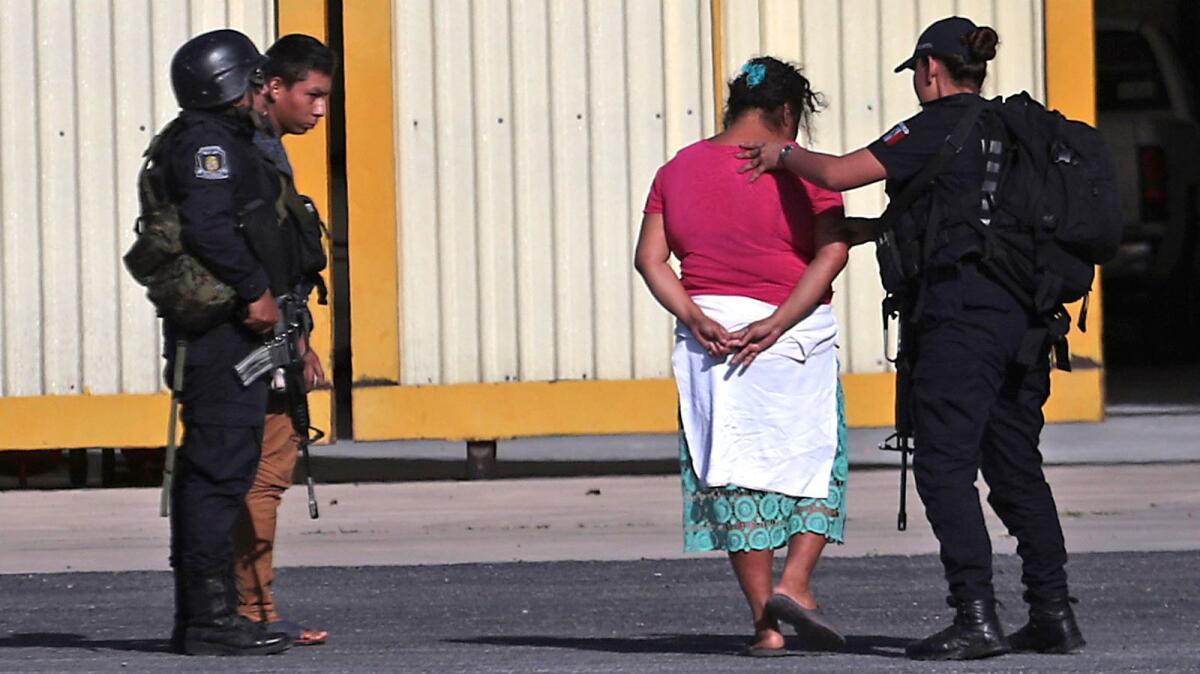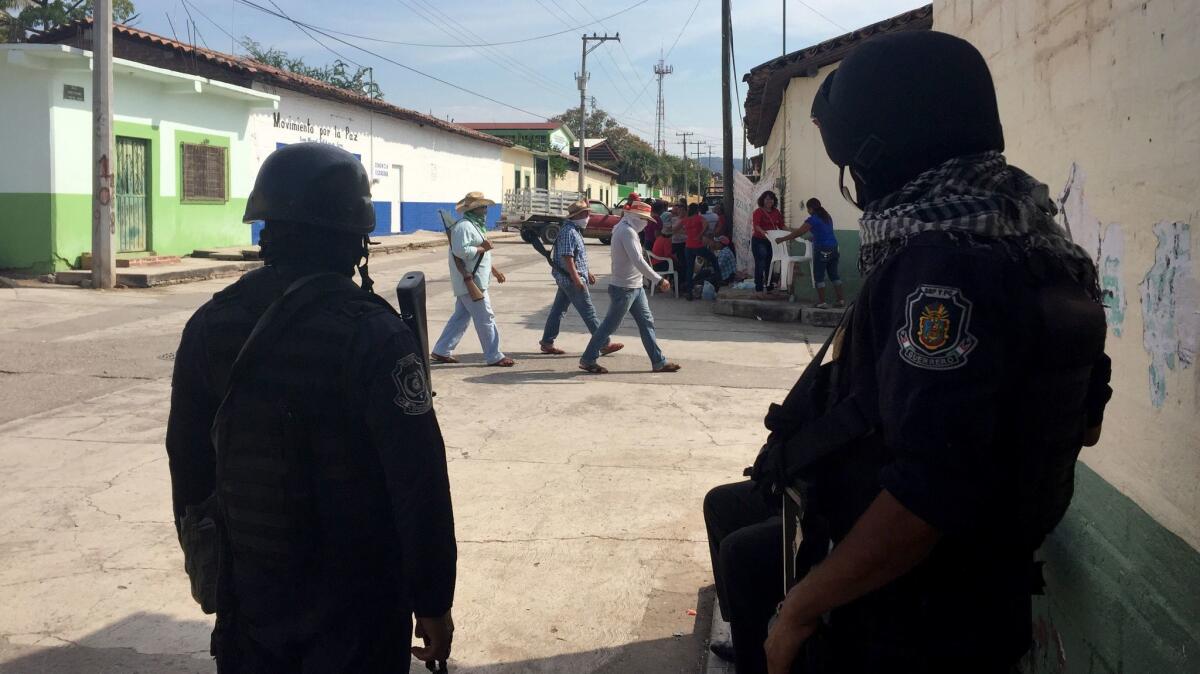In one small Mexican town, the citizens become armed vigilantes to take on a drug gang

Reporting from San Miguel Totolapan, Mexico — The self-proclaimed good guys, masked men bearing shotguns and ancient hunting rifles, kept guard last week outside what used to be the town police station, back when the town still had a police force. Emblazoned in large blue letters against a white facade were the words “Movement for Peace.”
“The people couldn’t take it anymore,” said one of the men, who hid his face behind a yellow handkerchief and identified himself only as Jose, a 42-year-old father of three. “The government does nothing to help, and we want peace for the future generations.
“Maybe in the end, they will kill us all, including our families,” he said, drawing nods from the other vigilantes hunched in white plastic chairs in a sliver of shade. “But we are in this till the final reckoning.”
Maybe in the end, they will kill us all, including our families
— Jose, a 42-year-old father of three
Inside the building, fellow townsfolk were holding at least 17 hostages they say were members or allies of the local drug gang.
After years of violence and intimidation, the fed-up citizens of San Miguel Totolapan, population 4,000, had taken the perilous step of striking back against Los Tequileros (“the Tequila drinkers”), the syndicate that dominates drug trafficking and other illicit activity in this steamy stretch of Guerrero state in southwestern Mexico. Their tactics included kidnapping the mother of a gang kingpin.
The violence-ridden region is a major production zone of the opium poppy, the raw material used to produce heroin smuggled north to the United States. The zone is also an abyss of lawlessness.
Armed bands, including Los Tequileros, battle for control of the lucrative smuggling trade in the so-called tierra caliente, or hot land. The phrase refers to the area’s stifling heat and humidity but has taken on additional meaning as organized crime has soared.
Guerrero state authorities reported a record 2,068 homicides between January and November 2016. November topped the list with 231 killings.
The fragmented drug gangs also traffic in extortion, kidnapping, robbery and murder. Los Tequileros boasts its own “special forces” of professional killers with colorful nicknames. Last year, police arrested an alleged tequilero enforcer, Juan Vargas Macedo, a.k.a. “El Garfield.”
The thuggish turmoil has left some towns, including San Miguel Totolapan, as virtual no-go zones, where residents say police and the army are seldom seen. Taxi drivers in the nearby market town of Altamirano politely demur when asked for a lift here.
“Demasiado peligroso,” they say. Too dangerous.
The town cops were in cahoots with the criminals, according to state authorities, who solved that problem two years ago by disbanding the police force. No one filled the law enforcement void.
Some nearby hamlets are abandoned because residents decamped in fear. Gouges from high-caliber rounds mark a few buildings along winding roads through stands of corn, bean fields and dense brush where cows and goats graze.
In June 2014, the bullet-riddled body of Maria Felix Jaimes, a former councilwoman in San Miguel Totolapan, was found with a placard, presumably from Los Tequileros.
“This is going to happen to anyone who passes information to ‘the fish,’ ” said the sign, referring to the head of a rival gang known as the Michoacan Family. “You are next.”
Last week, things reached a boiling point here.
It started with the kidnapping last Sunday of 37-year-old Isauro de Paz Duque, a widely respected engineer whose firm is one of the area’s few regular sources of employment.
In retaliation the next day, townsfolk launched a dicey gambit.
Calling themselves a “self-defense force,” they took up arms and abducted the mother of Raybel Jacobo de Almonte, known as El Tequilero (“the Tequila Drinker”), notorious capo of the gang that bears his handle. The vigilantes abducted at least 17 others who they said were were linked to his mob.
The drama played out on videos posted on YouTube.
Yadira Guillermo, wife of the kidnapped engineer, appeared in a clip urging the Guerrero governor to intervene to secure the release of her husband.
“We have here … the mother of the man called Tequilero,” the wife declared. “I ask for an exchange: I will deliver his mother if they deliver my husband. … But I want him safe and sound.”
The gaunt-looking mother, Maria Felix de Almonte, was videotaped in captivity pleading with her infamous offspring to do the right thing.
“Look, son, if you have the engineer, turn him over, please,” she said in a chastising tone as she looked into the camera. “If you have him, I’m confident that you will release him. Do it, please.”
Her son is a figure of dark legend here. Authorities say he is wanted on suspicion of murder, kidnapping and extortion, among other crimes. Last month, he eluded a massive manhunt.
“All indications are that he is hiding out in caves,” the state’s top prosecutor, Xavier Olea, told local radio at the time.
“He’s not someone who can be walking in the mountains for two or three hours,” added the prosecutor, noting that de Almonte suffers from a bullet wound to a leg and sometimes must be carried by his confederates.
By late Wednesday, the vigilantes and Los Tequileros struck a deal. News footage showed the engineer being reunited with his wife and children. A separate clip documented El Tequilero’s frail mother stepping into a pickup, surrounded by heavily armed state police.
Even with the other hostages still captive, some measure of calm returned to San Miguel Totolapan by the next day. State and federal police pickups rumbled up and down largely abandoned streets. In the central plaza, the doors to city hall were opened, but no one was inside. A plastic Christmas tree towered above the mostly vacant plaza.

Women with scarves concealing their faces waved white flags and occasionally chanted, “We want peace!”
“Really, we are all just tired of the lawlessness and violence,” said one of them, who identified herself only as Maria out of fear, she said, that the gangs would retaliate against her for taking part in the vigilante uprising.
A mother of three, she said she was familiar with kidnapping, having been a victim two years ago when she was held for a week until her family paid a ransom. “I am only fortunate to be here alive today,” she said.
The armed “self-defense” militiamen lingered outside the former police headquarters, their hostages inside. They conceded that in confronting the thugs, they had resorted to their tactics.
But the vigilantes said they had no choice: It was the only way anybody would listen to them.
On Friday, the state police and army met the demands of the townsfolk and agreed to establish a strong local presence and hunt down the fugitive El Tequilero. In return, the citizens released the hostages.
The crisis appeared to have passed, for now.
De Paz, the engineer whose kidnapping sparked the confrontation, has been welcomed back as a hero since his release. Outside his home, ecstatic neighbors embraced him and celebrated his survival.
“The people of this pueblo never raised arms till now,” he said.
“The people took to the streets, and that is their right,” added a smiling de Paz. “They have had enough with what is going on in this country. … It’s like when a person has a fever. That means something is wrong, no? Or when a car overheats. Eventually it explodes. That is what happened here in San Miguel.”
Cecilia Sanchez of The Times’ Mexico City bureau contributed to this article.
ALSO
Philippine President Duterte confirms he killed people as mayor, with no remorse
Aleppo’s sorrow: Scenes from Syria’s ruined city
Chinese who first glimpsed American culture through Alan Thicke mourn his death
More to Read
Sign up for Essential California
The most important California stories and recommendations in your inbox every morning.
You may occasionally receive promotional content from the Los Angeles Times.










